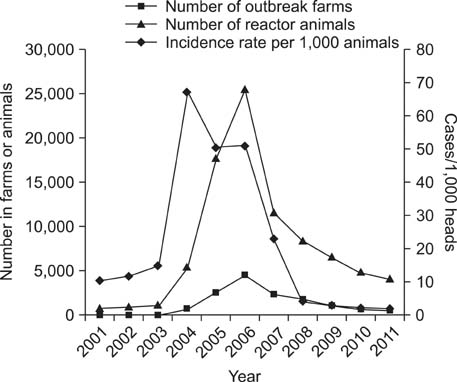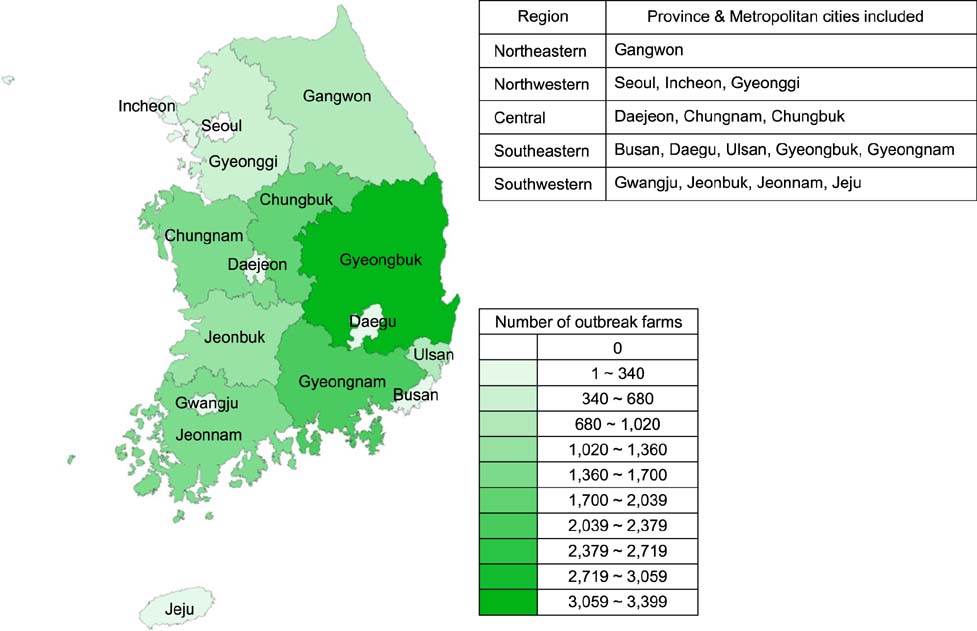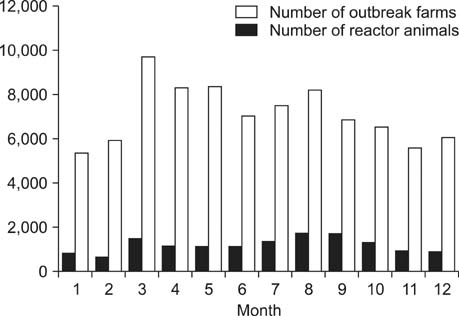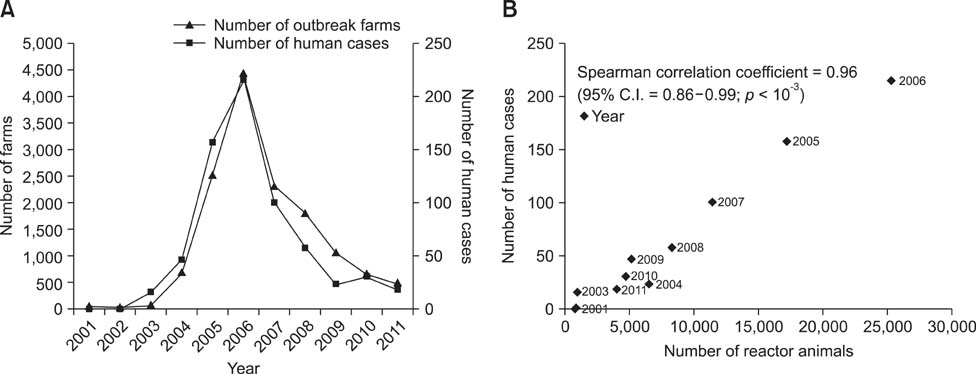J Vet Sci.
2014 Dec;15(4):537-543. 10.4142/jvs.2014.15.4.537.
Epidemiology of brucellosis among cattle in Korea from 2001 to 2011
- Affiliations
-
- 1Division of Veterinary Epidemiology, Animal and Plant Quarantine Agency, Anyang 430-757, Korea. heleney@korea.kr
- 2College of Veterinary Medicine, Konkuk University, Seoul 143-701, Korea.
- 3OIE Reference Laboratory for Brucellosis, Animal and Plant Quarantine Agency, Anyang 430-757, Korea.
- KMID: 2070240
- DOI: http://doi.org/10.4142/jvs.2014.15.4.537
Abstract
- In the present study, the outbreak patterns of bovine brucellosis in Korea from 2000 to 2011 were analyzed to understand the epidemiological evolution of this disease in the country. A total of 85,521 brucella reactor animals were identified during 14,215 outbreaks over the 12-year study period. The number of bovine brucellosis cases increased after 2003 and peaked in 2006 before decreasing thereafter. The majority of the bovine brucellosis cases were Korean native cattle, Han Woo. The numbers of human brucellosis cases and cattle outbreaks increased and decreased in the same pattern. The correlation coefficient for human and bovine cases per year was 0.96 (95% confidence interval = 0.86~0.99; p < 10(-3)). The epidemiological characteristics of bovine brucellosis appeared to be affected by the intensity of eradication programs that mainly involved a test-and-slaughter policy. Findings from the present study were based on freely available statistics from web pages maintained by government agencies. This unlimited access to information demonstrates the usefulness of government statistics for continually monitoring the health of animal populations.
Keyword
MeSH Terms
Figure
Cited by 2 articles
-
An Imported Case of Brucella melitensis Infection in South Korea
Jee Young Lee, Yongduk Jeon, Mi Young Ahn, Hea Won Ann, In Young Jung, Wooyong Jung, Moo Hyun Kim, Jin Young Ahn, Je Eun Song, Yong Chan Kim, Dong Hyun Oh, Eun Jin Kim, Su Jin Jeong, Nam Su Ku, Hyunsoo Kim, Kyungwon Lee, June Myung Kim, Jun Yong Choi
Infect Chemother. 2018;50(2):149-152. doi: 10.3947/ic.2018.50.2.149.Tannic acid-mediated immune activation attenuates Brucella abortus infection in mice
Alisha W. B. Reyes, Huynh T. Hop, Lauren T. Arayan, Tran X. N. Huy, Wongi Min, Hu Jang Lee, Hong Hee Chang, Suk Kim
J Vet Sci. 2018;19(1):51-57. doi: 10.4142/jvs.2018.19.1.51.
Reference
-
1. Arambulo P 3rd. International programs and veterinary public health in the Americas-success, challenges, and possibilities. Prev Vet Med. 2008; 86:208–215.
Article2. Bernués A, Manrique E, Maza MT. Economic evaluation of bovine brucellosis and tuberculosis eradication programmes in a mountain area of Spain. Prev Vet Med. 1997; 30:137–149.
Article3. Calistri P, Iannetti S, Atzeni M, Di Bella C, Schembri P, Giovannini A. Risk factors for the persistence of bovine brucellosis in Sicily from 2008 to 2010. Prev Vet Med. 2013; 110:329–334.
Article4. Corbel MJ. Brucellosis: an overview. Emerg Infect Dis. 1997; 3:213–221.
Article5. Coulibaly ND, Yameogo KR. Prevalence and control of zoonotic diseases: collaboration between public health workers and veterinarians in Burkina Faso. Acta Trop. 2000; 76:53–57.
Article6. Economides P. Control of zoonoses in Cyprus. Rev Sci Tech. 2000; 19:725–734.
Article7. Grossklaus D. Zoonoses control-new challenges in health protection of consumers. Berl Munch Tierarztl Wochenschr. 2001; 114:420–427.8. Hässig M, Paganini C, Simmen-Fritschy B, Knab C, Herren M. Perception of zoonosis in veterinary medicine and society. Schweiz Arch Tierheilkd. 2010; 152:355–362.9. Her M, Kang SI, Kim JW, Kim JY, Hwang IY, Jung SC, Park SH, Park MY, Yoo H. A genetic comparison of Brucella abortus isolates from animals and humans by using the MLVA assay. J Microbiol Biotechnol. 2010; 20:1750–1755.10. John K, Kazwala R, Mfinanga GS. Knowledge of causes, clinical features and diagnosis of common zoonoses among medical practitioners in Tanzania. BMC Infect Dis. 2008; 8:162.
Article11. KAHIS. Statistics on notifiable animal diseases occurrence. Korea Animal Health Integrated System. Anyang: Animal and Plant Quarantine Agency;2013.12. KAHIS. Information on animal disease occurrence. Korea Animal Health Integrated System. Anyang: Animal and Plant Quarantine Agency;2013.13. Kim JY, Her M, Kang SI, Lee K, Lee HK, Jung SC. Epidemiologic relatedness between Brucella abortus isolates from livestock and wildlife in South Korea. J Wildl Dis. 2013; 49:451–454.
Article14. Infectious Diseases Surveillance Yearbook, 2011. Korea Centers for Disease Control and Prevention. Public Health Weekly Report. Osong: Korea Centers for Disease Control and Prevention;2012; 5:6. 7. 25. 32. 34. 40. 100. 342. 406.15. KOSTAT. Statistical Geographic Information Service 2001-2011. Daejeon: Stastics Korea;2013.16. Lee BY, Higgins IM, Moon OK, Clegg TA, McGrath G, Collins DM, Park JY, Yoon HC, Lee SJ, More SJ. Surveillance and control of bovine brucellosis in the Republic of Korea during 2000-2006. Prev Vet Med. 2009; 90:66–79.
Article17. Lee HS, Her M, Levine M, Moore GE. Time series analysis of human and bovine brucellosis in South Korea from 2005 to 2010. Prev Vet Med. 2013; 110:190–197.
Article18. Lim HS, Min YS, Lee HS. Investigation of a series of brucellosis cases in Gyeongsangbuk-do during 2003-2004. J Prev Med Public Health. 2005; 38:482–488.19. Marcotty T, Thys E, Conrad P, Godfroid J, Craig P, Zinsstag J, Meheus F, Boukary AR, Badé MA, Sahibi H, Filali H, Hendrickx S, Pissang C, Van Herp M, van der Roost D, Thys S, Hendrickx D, Claes M, Demeulenaere T, van Mierlo J, Dehoux JP, Boelaert M. Intersectoral collaboration between the medical and veterinary professions in low-resource societies: The role of research and training institutions. Comp Immunol Microbiol Infect Dis. 2013; 36:233–239.
Article20. Notice 2014-13. Ministry of Agriculture, Food and Rural Affairs (KR). Standard operation procedure on tuberculosis and brucellosis. 2014. 03. 17.21. Ministry of Agriculture, Food and Rural Affairs. Agriculture, Food and Rural Affairs Statistics Yearbook 2013. Sejong: Ministry of Agriculture, Food and Rural Affairs;2013.22. Ministry of Agriculture, Food and Rural Affairs. Plan of Operation and Implementation for Animal Disease Control 2014. Sejong: Ministry of Agriculture, Food and Rural Affairs;2014.23. Park SY, Kim TJ, Yoon H, Kim JY, Lee MJ, Lee WC. A retrospective study of the extensive eradication program for brucellosis outbreaks and control in Korea, 2002-2009. Jpn J Infect Dis. 2012; 65:427–429.
Article24. Snedeker KG, Anderson MEC, Sargeant JM, Weese JS. A survey of Canadian public health personnel regarding knowledge, practice and education of zoonotic diseases. Zoonoses Public Health. 2012; 60:519–525.
Article25. Turner AJ. Endemic disease control and regulation in Australia 1901-2010. Aust Vet J. 2011; 89:413–421.
Article26. Wee SH, Nam HM, Kim CH. Emergence of brucellosis in cattle in the Republic of Korea. Vet Rec. 2008; 162:556–557.
Article27. Wee SH, Kim CH, More SJ, Nam HM. Mycobacterium bovis in Korea: an update. Vet J. 2010; 185:347–350.28. World Organisation for Animal Health. Chap. 8.4. Infection with Brucella abortus, B. melitensis and B. suis. Terrestrial Animal Health Code. 23rd eds. Paris: OIE;2014.29. Yoo SJ, Choi YS, Lim HS, Lee K, Park MY, Chu C, Kang YA. Seroprevalence and risk factors of brucellosis among slaughterhouse workers in Korea. J Prev Med Public Health. 2009; 42:237–242.
Article30. Yoon H, Nam HM, Kim CH, Park CK, Kang MI, Wee SH. Risk factors for bovine brucellosis in Korea: a case control study. Korean J Vet Public Health. 2006; 30:77–87.31. Yoon H, Moon OK, Her M, Carpenter TE, Kim YJ, Jung S, Lee SJ. Impact of bovine brucellosis eradication programs in the Republic of Korea. Prev Vet Med. 2010; 95:288–291.
Article32. Zinsstag J, Schelling E, Roth F, Bonfoh B, de Savigny D, Tanner M. Human benefits of animal interventions for zoonosis control. Emerg Infect Dis. 2007; 13:527–531.
Article
- Full Text Links
- Actions
-
Cited
- CITED
-
- Close
- Share
- Similar articles
-
- A Case Report of Human Brucellosis Found by Zoonoses Surveillance System Based on One Health
- Seroprevalence and risk factors for bovine brucellosis in Jordan
- A Sporadic Outbreak of Human Brucellosis in Korea
- Investigation of a Series of Brucellosis Cases in Gyeongsangbuk-do during 2003-2004
- Epidemiological characteristics of bovine brucellosis in Korea, 2000~2004





